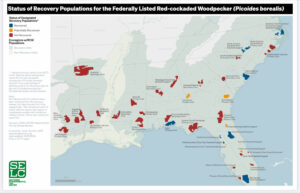March 2025 BOTY Blog

Welcome back to our bird of the year blog!
Here is an adorable picture of our beloved Red-cockaded woodpecker peeking his head out of a nest-cavity. These birds thrive in their old-growth Longleaf Pine forest habitat. However, the destruction of this beautiful, unique ecosystem is one of the main reasons why these birds are facing extinction. In fact, red-cockaded woodpeckers were one of the first species to have been put on the endangered species list during the 1970s.
Historically, the “woodpecker’s range extended from Florida to New Jersey, as far west as Texas and Oklahoma, and inland to Missouri, Kentucky, and Tennessee, with an original population numbering over 1.5 million”. Today, however, that number has decreased to about 15,000 birds- less than 1 percent of the woodpecker’s population at the time of European settlement. This decline reflects the woodpeckers’ affinity to older, living Longleaf Pines. As these old growth forests were decimated by logging, opportunities for these woodpeckers to maintain colonies were lost, and habitat was fragmented or decreased in size. Furthermore, the historic suppression of naturally occurring fires has limited the maintenance of more open forests that birds prefer. Finally, as climate change is currently altering the planet, bigger and more frequent natural disasters may pose a threat to the remaining habitat of the red cockaded woodpecker.

Status of Recovery Populations for the Red Cockaded Woodpecker
Moving Forward
As education around the importance of old-growth forests and frequent application of prescribed burns grows, the bird’s numbers have been bouncing back. From 1,470 “clusters” of red cockaded woodpeckers in the 1970s to approx. 7,800 today, red-cockaded woodpecker populations have recovered. So much so that the U.S. The Fish and Wildlife Service has decided to downlist the red-cockaded woodpecker from endangered to threatened status under the Endangered Species Act.
There has been pushback to this decision, with many saying the decision is premature and does not consider the vulnerability of these clusters to environmental threats caused by increasingly fragmented forests. Either way, the protection of this beautiful species should still be a priority for conservation in southern states, and should be a fight we should all take part in. Support your local wildlife and nonprofits organizations as we continue the push against habitat loss, and I’ll see you next month.
Until then,
Nancy
Wake Audubon Volunteer


